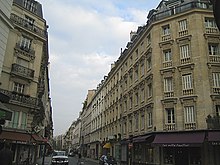Claude-Philibert Barthelot de Rambuteau
Claude-Philibert Barthelot, comte de Rambuteau (born November 9, 1781 in Mâcon , † April 23, 1869 at Château de Rambuteau near Ozolles ) was a French politician and civil servant in the first half of the 19th century.
Rambuteau was a civil servant at the Conseil d'État (France) , Peer of France and especially from 1833 to 1848 prefect of the Seine department . In this role he laid the foundations for the fundamental transformation of the city of Paris , which Baron Haussmann carried out during the Second Empire .
His mandate as prefect was characterized by the implementation of his theories of hygiene . A year before his appointment, Paris was hit by a cholera epidemic. Rambuteau believed the narrow, winding streets of central Paris to be one of the factors contributing to the spread of cholera. He initiated the breakthrough of a 13-meter-wide street in the city center, one of the first in the city. This street has been called rue Rambuteau since 1839 . During his tenure, the triumphal arch was completed and work began on the Avenue des Champs-Élysées .
According to his motto "de l'eau, de l'air, de l'ombre" ( water, air, shade ), he had the Paris sewer system modernized and had many fountains built, some of which are still in operation in public gardens. He pushed ahead with the erection of gas lanterns and had trees planted on avenues. At the beginning of his tenure, the city had 69 gas lamps , at the end of 8,600 . He also had vespasiennes built on public roads - public urinals .
Despite a public interest dispossession act dated May 3, 1841, Rambuteau did not have the resources or ambitions that would later allow Haussmann to carry out the great works on the city that Rambuteau pointed out.
The Rambuteau station of the Paris subway at the Center Pompidou at the intersection of rue Rambuteau / rue Beauburg is named after him.
| personal data | |
|---|---|
| SURNAME | Rambuteau, Claude-Philibert Barthelot de |
| ALTERNATIVE NAMES | Claude Philibert Barthelot |
| BRIEF DESCRIPTION | French politician and civil servant |
| DATE OF BIRTH | November 9, 1781 |
| PLACE OF BIRTH | Mâcon |
| DATE OF DEATH | April 23, 1869 |
| Place of death | Château de Rambuteau |
